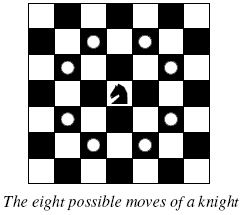A Knight's Journey
| Time Limit: 1000MS | Memory Limit: 65536K | |
| Total Submissions: 25252 | Accepted: 8584 |
Description
 Background
Background
The knight is getting bored of seeing the same black and white squares again and again and has decided to make a journey
around the world. Whenever a knight moves, it is two squares in one direction and one square perpendicular to this. The world of a knight is the chessboard he is living on. Our knight lives on a chessboard that has a smaller area than a regular 8 * 8 board, but it is still rectangular. Can you help this adventurous knight to make travel plans?
Problem
Find a path such that the knight visits every square once. The knight can start and end on any square of the board.
Input
The input begins with a positive integer n in the first line. The following lines contain n test cases. Each test case consists of a single line with two positive integers p and q, such that 1 <= p * q <= 26. This represents a p * q chessboard, where p describes how many different square numbers 1, . . . , p exist, q describes how many different square letters exist. These are the first q letters of the Latin alphabet: A, . . .
Output
The output for every scenario begins with a line containing "Scenario #i:", where i is the number of the scenario starting at 1. Then print a single line containing the lexicographically first path that visits all squares of the chessboard with knight moves followed by an empty line. The path should be given on a single line by concatenating the names of the visited squares. Each square name consists of a capital letter followed by a number.
If no such path exist, you should output impossible on a single line.
If no such path exist, you should output impossible on a single line.
Sample Input
3 1 1 2 3 4 3
Sample Output
Scenario #1: A1 Scenario #2: impossible Scenario #3: A1B3C1A2B4C2A3B1C3A4B2C4
Source
TUD Programming Contest 2005, Darmstadt, Germany
题意:
给出国际象棋棋盘的行数和列数,判断马能不能不重复地走遍所有格子,若能,则按字典序输出走动路径
在国际象棋中马走“日”字格
代码:
#include<cstdio>
#include<cstring>
#include<cstdlib>
#include<string>
#define N 27
typedef struct Node
{
int row,col;
}node;
node way[N*N];
int p,q; //p为数字行,q为字母列
bool chess[N][N]; //每次查找时标记该位置有没有被走到过
int dx[8]={-1,1,-2,2,-2,2,-1,1}; //dfs时棋子走动顺序,注意顺序
int dy[8]={-2,-2,-1,-1,1,1,2,2};
bool dfs(int i,int j,int step) //step为当前行走步数
{
chess[i][j]=true;
way[step].row=i;
way[step].col=j;
if(step==p*q) return true; //step==p*q则所有格子都被走到
for(int k=0;k<8;k++)
{
int ii=i+dx[k];
int jj=j+dy[k];
if(!chess[ii][jj] && ii>=1 && ii<=p && jj>='A' && jj<='A'+q-1)
if(dfs(ii,jj,step+1))
return true;
}
chess[i][j]=false; //执行至此,前面8步均不能成立,返回上一层
return false;
}
int main()
{
int Case=1,t;
while(scanf("%d",&t)!=EOF)
{
if(t==-1) break;
while(t--)
{
memset(chess,false,sizeof(chess));
scanf("%d%d",&p,&q);
bool flag=false;
for(int j='A';j<='A'+q-1;j++)
{
for(int i=1;i<=p;i++)
{
memset(way,0,sizeof(way));
if(dfs(i,j,1))
{
printf("Scenario #%d:\n",Case++);
for(int k=1;k<=p*q;k++)
printf("%c%d",way[k].col,way[k].row);
printf("\n\n");
flag=true;
break;
}
}
if(flag) break;
}
if(!flag)
{
printf("Scenario #%d:\n",Case++);
printf("impossible\n\n");
}
}
}
return 0;
}思路:
因为要求按字典序输出,则要注意深度搜索时的顺序





















 873
873

 被折叠的 条评论
为什么被折叠?
被折叠的 条评论
为什么被折叠?








